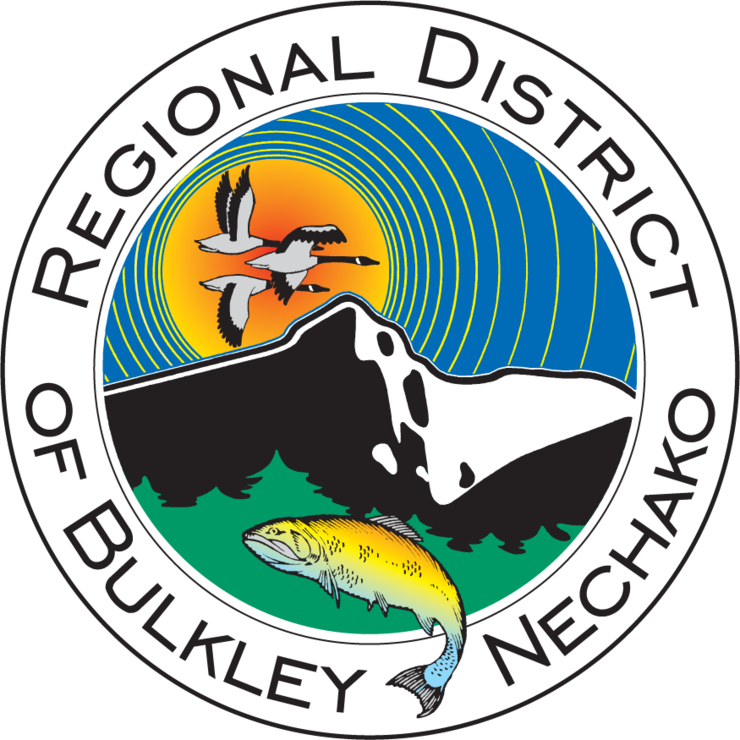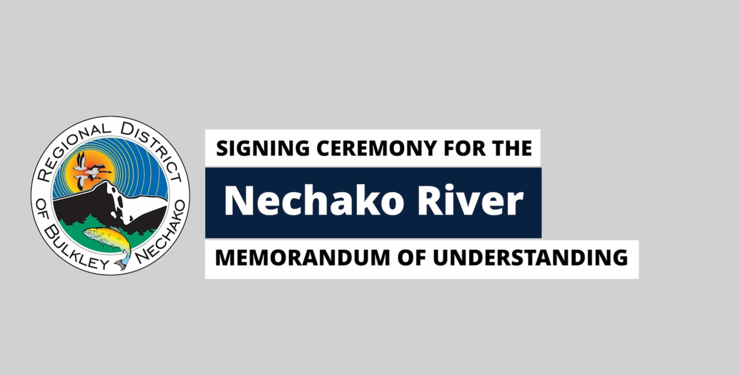For Release – November 18, 2024
Territories of the Nechako First Nations
Today, on the banks of the Nechako River, Chiefs from Saik’uz First Nation, Stellat’en First Nation, Nadleh Whut’en, and Cheslatta Carrier Nation, along with the Mayor of Vanderhoof and Chair of the Regional District of Bulkley-Nechako gathered to sign the renewed Nechako River Memorandum of Understanding.
The MOU commits the parties to work together to restore the health of the Nechako River, its affected tributaries and its fish populations, with a particular focus on salmon and sturgeon populations that are on the precipice of extinction. It also calls for government-to-government collaboration to develop a water sustainability plan to identify environmental flow needs and risks to aquatic ecosystem health, and further to determine restoration measures for the damaged ecosystems of the Nechako Watershed.
Originally signed on September 29, 2021, the MOU has been amended to include Cheslatta Carrier Nation and the District of Vanderhoof as signatories. Together—and with Rio Tinto Alcan, the Province of BC, Canada, other First Nations, and various interest holders in the watershed—the parties are optimistic that solutions can be found for the complex problems facing the Nechako River.
In 2022, the Supreme Court of British Columbia found taht infrastructure installation and operation on the Nechako River has had negative effects on the abundance and health of the fish population in the Watershed and recognized Aboriginal right to fish the Nechako Watershed for food, social, and ceremonial purposes.
Renewing the MOU affirms the ongoing relationship between the First Nations and local governments involved. It represents a commitment to continue working together to restore the health of the Nechako River. The MOU signing was celebrated at a signing ceremony on the banks of the Nechako River in Vanderhoof.
Contacts:
Mark Parker, Chair Kevin Moutray, Mayor
Regional District of Bulkley-Nechako District of Vanderhoof
250-692-3195 250-567-4711
mark.parker@rdbn.bc.ca kmoutray@district.vanderhoof.ca
Chief Priscilla Mueller Chief Beverly Ketlo
Saik’uz First Nation Nadleh Whut’en
250-567-9293 250-690-7211
priscilla.mueller@saikuz.com bketlo@nadleh.ca
Chief Robert Michell Chief Corrina Leween
Stellat’en First Nation Cheslatta Carrier Nation
250-699-8747 250-694-3334
chief@stellaten.ca cleween@cheslatta.com
Quotes:
Mark Parker, RDBN Chair
This is a great day for the Regional District of Bulkley-Nechako, District of Vanderhoof, Saik’uz First Nation, Nadleh Whut’en, Stellat’en First Nation (Nechako First Nations), and Cheslatta Carrier Nation. Today we sign this MOU as a symbol of unity to address common concerns around the flow and health of the Nechako River. Together, we will work to restore a more natural flow regime, ensuring long-term health of the Nechako River for current and future generations.
Kevin Moutray, Mayor of Vanderhoof
Vanderhoof Council is grateful to formalize this Memorandum of Understanding with the Regional District of Bulkley-Nechako and our First Nations neighbours. It reflects our shared commitment to protecting the river, ensuring sustainable management practices, and respecting Indigenous knowledge and stewardship.
Chief Priscilla Mueller, Saik’uz First Nation
Today marks another pivotal step forward as we formalize this Memorandum of Understanding between the District of Vanderhoof, the Regional District of Bulkley-Nechako and the Cheslatta Carrier Nation. This MOU is not just a symbolic gesture; it represents a commitment to collective action, mutual respect, and shared responsibility. The health of the Nechako watershed impacts all who live here—Indigenous Nations and non-Indigenous communities alike.
While we acknowledge the progress made, we must be unequivocal: there is much work ahead. Addressing the complex challenges facing our watershed requires action not just at the local level but at provincial and federal levels as well. Real change will only come when all parties, from the grassroots to the highest levels of government, unite in shared purpose and accountability.
This agreement strengthens our resolve and underscores the necessity of solidarity. Together, we can build the foundation for a sustainable and thriving future for the Nechako and everyone who depends on its vitality. The time for incremental steps is over. We need bold, coordinated action, and we stand ready to lead the way.
Chief Beverly Ketlo, Nadleh Whut'en
This MOU is an example of the progress we are making on a difficult issue, the health of the Nechako River. It is critically important that we come together as communities and collaborate to improve river flow and temperature to protect endangered sturgeon and salmon. These are both very important species that our community used to rely on, and we haven’t been able to harvest them for years. The Nautley River is a vital artery to the Nechako within our community. It is where we gather together for harvest, and the fish collected is critically important to health and food security for our members. Without the fish to harvest and process, we also lose extremely important family and community cultural connection.
Climate change requires immediate action before we get to the point of extinction for these species in our rivers - the river is at the lowest levels we have seen in our lifetime. This MOU advances reconciliation by showing that we will support each other and do the hard work required to improve the health of the river for everyone in the region and future generations.
Chief Robert Michell, Stellat'en First Nation
The Stellat’en people have been involved with trying to protect the Nechako River for decades, including our court case initiated in 2011. That decision indicated that the Province and Industry have a duty to protect Indigenous rights as well as river health. We continue to try and make sure the river is a better place for all. It has been devastating for our members to lose our fish harvest, we have been unable to fish for food for several years due to poor salmon stocks.
This partnership with other governments is critical, as we have all had the same concerns about river health for years, but we used to work in silos. Now we have opened the door for transparent communication and strengthened our voices by speaking together to advocate for change.
Chief Corrina Leween, Cheslatta Carrier Nation
Cheslatta Carrier Nation is proud to join as a signatory to this important Memorandum of Understanding. The Nechako River is vital to all our communities, both upstream and downstream. Cheslatta is upstream of the Kenney Dam and part of the community that gets flooded every year. It is time to heal the Nechako River for all the communities, both Indigenous and non-Indigenous. I am so pleased that our neighbours have invited us to participate in this important work together. Climate change is having detrimental impacts in many areas. Water sustains us, and it is up to us to protect our environment for future generations. One by one we can do that, but together we can do it even better. This work is important for the Nechako, and for the world in general.
Backgrounder:
Historically, the Nechako River was one of the largest tributaries of the Fraser River. It was the breeding ground for the Nechako white sturgeon and contributed significantly to highly valued salmon populations.
The headwaters of the Nechako River lie within the Nechako Reservoir, an enormous body of water created by the construction of the Kenney Dam to provide hydroelectric power to an aluminium smelter in Kitimat. Completion of the Dam in the 1950s fundamentally altered the flow patterns of the Nechako River. Most of the water that would have otherwise flowed down the Nechako River has been diverted west, through the mountains to produce hydroelectric power for the smelter. From 1985-2018, the average flow in the Upper Nechako River is estimated to have been just ~36% of the natural flow prior to the construction of the Dam. Further, the 11 kilometers immediately below the Dam have been dry since construction.
The reduction in the natural flow has significantly affected the river’s fish populations and habitat. The Nechako white sturgeon has been suffering from “chronic recruitment failure” since at least 1980 and is on the precipice of extinction. The lack of spring freshet and the dewatering of the floodplain and side channels are impairing chinook salmon productivity and recruitment. Migrating sockeye salmon in the Nechako River encounter artificially warm water temperatures that are affecting pre-spawn mortality.
The Nechako River is of spiritual significance and cultural importance to the Nechako First Nations, whose members are descendants of the Indigenous inhabitants who lived along and relied upon the Nechako River since time immemorial. The Kenney Dam has fundamentally altered the Nechako River and interfered with the Nechako First Nations’ and Cheslatta Carrier Nation’s Aboriginal title and rights. The on-going, unjustified infringements of Aboriginal title and rights are inconsistent with the principles in the legislation passed by the BC Legislature to implement the United Nations Declaration on the Rights of Indigenous Peoples.
In 2011, Saik’uz and Stellat’en commenced an action against Rio Tinto in the Supreme Court of British Columbia to obtain a court order to restore the natural flow to the Nechako River. In 2022, the Supreme Court of British Columbia found that the installation and operation of the Kenney Dam and related infrastructure, and the resulting alteration of the Nechako River’s natural flow, has had negative effects on the abundance and health of the fish population in the Watershed. The Court ruled that Saik’uz and Stellat’en have a constitutionally recognized Aboriginal right to fish the Nechako Watershed for food, social, and ceremonial purposes, the modern continuation of a practice and way of life that pre-existed the incursion of European explorers and settlers into their traditional territories in the first decade of the 1800’s. And further, the ongoing impact of the Kenney Dam continues to infringe the plaintiffs’ Aboriginal rights as does the Crown’s persistent refusal to consult with the plaintiffs on river flow (Thomas and Saik’uz First Nation v. Rio Tinto Alcan Inc., 2022 BCSC 15). The Court’s findings of fact and ruling were affirmed by the Court of Appeal for British Columbia (2024 BCCA 62).
Current operation of the Kenney Dam and Nechako Reservoir are incompatible with reconciliation between Indigenous and non-Indigenous peoples in the Nechako region. The Regional District of Bulkley-Nechako and the District of Vanderhoof stand shoulder-to-shoulder with the Nechako First Nations and Cheslatta Carrier Nation in opposition to the continued degradation of the Nechako watershed and in the hope for a meaningful role in the management of a new, more natural flow regime.

The Nechako River at Cheslatta Falls (left) in May 2021. Right: The Upper Nechako River, where flow is virtually eliminated due to the Kenney Dam.
Source: Nechako First Nations

Map of the Nechako Reservoir, Nechako River, Nautley River, and surrounding area.
Source: Nechako Environmental Enhancement Fund.


